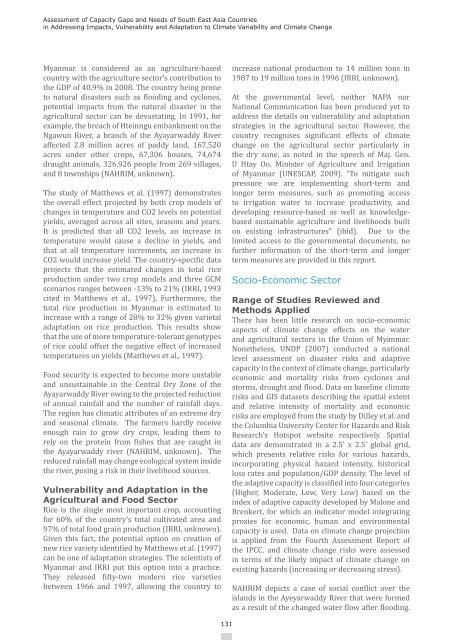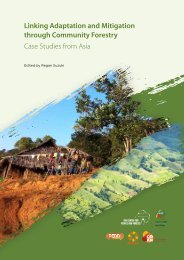Desktop Study on - Regional Climate Change Adaptation ...
Desktop Study on - Regional Climate Change Adaptation ...
Desktop Study on - Regional Climate Change Adaptation ...
Create successful ePaper yourself
Turn your PDF publications into a flip-book with our unique Google optimized e-Paper software.
Assessment of Capacity Gaps and Needs of South East Asia Countries<br />
in Addressing Impacts, Vulnerability and Adaptati<strong>on</strong> to <strong>Climate</strong> Variability and <strong>Climate</strong> <strong>Change</strong><br />
Myanmar is c<strong>on</strong>sidered as an agriculture-based<br />
country with the agriculture sector’s c<strong>on</strong>tributi<strong>on</strong> to<br />
the GDP of 40.9% in 2008. The country being pr<strong>on</strong>e<br />
to natural disasters such as flooding and cycl<strong>on</strong>es,<br />
potential impacts from the natural disaster in the<br />
agricultural sector can be devastating. In 1991, for<br />
example, the breach of Hteinngu embankment <strong>on</strong> the<br />
Ngawun River, a branch of the Ayayarwaddy River<br />
affected 2.8 milli<strong>on</strong> acres of paddy land, 167,520<br />
acres under other crops, 67,306 houses, 74,674<br />
draught animals, 326,926 people from 269 villages,<br />
and 8 townships (NAHRIM, unknown).<br />
The study of Matthews et al. (1997) dem<strong>on</strong>strates<br />
the overall effect projected by both crop models of<br />
changes in temperature and CO2 levels <strong>on</strong> potential<br />
yields, averaged across all sites, seas<strong>on</strong>s and years.<br />
It is predicted that all CO2 levels, an increase in<br />
temperature would cause a decline in yields, and<br />
that at all temperature increments, an increase in<br />
CO2 would increase yield. The country-specific data<br />
projects that the estimated changes in total rice<br />
producti<strong>on</strong> under two crop models and three GCM<br />
scenarios ranges between -13% to 21% (IRRI, 1993<br />
cited in Matthews et al., 1997). Furthermore, the<br />
total rice producti<strong>on</strong> in Myanmar is estimated to<br />
increase with a range of 28% to 32% given varietal<br />
adaptati<strong>on</strong> <strong>on</strong> rice producti<strong>on</strong>. This results show<br />
that the use of more temperature-tolerant genotypes<br />
of rice could offset the negative effect of increased<br />
temperatures <strong>on</strong> yields (Matthews et al., 1997).<br />
Food security is expected to become more unstable<br />
and unsustainable in the Central Dry Z<strong>on</strong>e of the<br />
Ayayarwaddy River owing to the projected reducti<strong>on</strong><br />
of annual rainfall and the number of rainfall days.<br />
The regi<strong>on</strong> has climatic attributes of an extreme dry<br />
and seas<strong>on</strong>al climate. The farmers hardly receive<br />
enough rain to grow dry crops, leading them to<br />
rely <strong>on</strong> the protein from fishes that are caught in<br />
the Ayayarwaddy river (NAHRIM, unknown). The<br />
reduced rainfall may change ecological system inside<br />
the river, posing a risk in their livelihood sources.<br />
Vulnerability and Adaptati<strong>on</strong> in the<br />
Agricultural and Food Sector<br />
Rice is the single most important crop, accounting<br />
for 60% of the country’s total cultivated area and<br />
97% of total food grain producti<strong>on</strong> (IRRI, unknown).<br />
Given this fact, the potential opti<strong>on</strong> <strong>on</strong> creati<strong>on</strong> of<br />
new rice variety identified by Matthews et al. (1997)<br />
can be <strong>on</strong>e of adaptati<strong>on</strong> strategies. The scientists of<br />
Myanmar and IRRI put this opti<strong>on</strong> into a practice.<br />
They released fifty-two modern rice varieties<br />
between 1966 and 1997, allowing the country to<br />
increase nati<strong>on</strong>al producti<strong>on</strong> to 14 milli<strong>on</strong> t<strong>on</strong>s in<br />
1987 to 19 milli<strong>on</strong> t<strong>on</strong>s in 1996 (IRRI, unknown).<br />
At the governmental level, neither NAPA nor<br />
Nati<strong>on</strong>al Communicati<strong>on</strong> has been produced yet to<br />
address the details <strong>on</strong> vulnerability and adaptati<strong>on</strong><br />
strategies in the agricultural sector. However, the<br />
country recognises significant effects of climate<br />
change <strong>on</strong> the agricultural sector particularly in<br />
the dry z<strong>on</strong>e, as noted in the speech of Maj. Gen.<br />
U Htay Oo, Minister of Agriculture and Irrigati<strong>on</strong><br />
of Myanmar (UNESCAP, 2009). “To mitigate such<br />
pressure we are implementing short-term and<br />
l<strong>on</strong>ger term measures, such as promoting access<br />
to irrigati<strong>on</strong> water to increase productivity, and<br />
developing resource-based as well as knowledgebased<br />
sustainable agriculture and livelihoods built<br />
<strong>on</strong> existing infrastructures” (ibid). Due to the<br />
limited access to the governmental documents, no<br />
further informati<strong>on</strong> of the short-term and l<strong>on</strong>ger<br />
term measures are provided in this report.<br />
Socio-Ec<strong>on</strong>omic Sector<br />
Range of Studies Reviewed and<br />
Methods Applied<br />
There has been little research <strong>on</strong> socio-ec<strong>on</strong>omic<br />
aspects of climate change effects <strong>on</strong> the water<br />
and agricultural sectors in the Uni<strong>on</strong> of Myanmar.<br />
N<strong>on</strong>etheless, UNDP (2007) c<strong>on</strong>ducted a nati<strong>on</strong>al<br />
level assessment <strong>on</strong> disaster risks and adaptive<br />
capacity in the c<strong>on</strong>text of climate change, particularly<br />
ec<strong>on</strong>omic and mortality risks from cycl<strong>on</strong>es and<br />
storms, drought and flood. Data <strong>on</strong> baseline climate<br />
risks and GIS datasets describing the spatial extent<br />
and relative intensity of mortality and ec<strong>on</strong>omic<br />
risks are employed from the study by Dilley et al. and<br />
the Columbia University Center for Hazards and Risk<br />
Research’s Hotspot website respectively. Spatial<br />
data are dem<strong>on</strong>strated in a 2.5’ x 2.5’ global grid,<br />
which presents relative risks for various hazards,<br />
incorporating physical hazard intensity, historical<br />
loss rates and populati<strong>on</strong>/GDP density. The level of<br />
the adaptive capacity is classified into four categories<br />
(Higher, Moderate, Low, Very Low) based <strong>on</strong> the<br />
index of adaptive capacity developed by Mal<strong>on</strong>e and<br />
Brenkert, for which an indicator model integrating<br />
proxies for ec<strong>on</strong>omic, human and envir<strong>on</strong>mental<br />
capacity is used. Data <strong>on</strong> climate change projecti<strong>on</strong><br />
is applied from the Fourth Assessment Report of<br />
the IPCC, and climate change risks were assessed<br />
in terms of the likely impact of climate change <strong>on</strong><br />
existing hazards (increasing or decreasing stress).<br />
NAHRIM depicts a case of social c<strong>on</strong>flict over the<br />
islands in the Ayeyarwaddy River that were formed<br />
as a result of the changed water flow after flooding.<br />
131

















